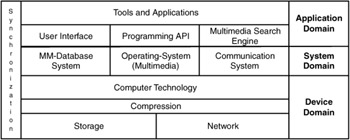1.2 Multimedia Systems and Databases
|
| < Day Day Up > |
|
1.2 Multimedia Systems and Databases
Multimedia systems will support media at many different levels of abstractions. Consider the following four applications: a Web-based multimedia application that manipulates images incorporated in the pages and streaming data that triggers the execution of an external viewer; a video editor that reads, writes, and manipulates video; an audio-video distribution service that distributes stored video information; and finally a multimedia search engine that finds videos in the Web that meet a certain search criteria.
At first, it appears that these multimedia applications do not have much in common. However, all of them can uniformly rely on a MMDBMS. One of the main tasks of a DBMS is to abstract the user from the details of storage access and its management and to serve as the front end to the user (i.e., to answer a content-based query, to resolve usage profiles, and to prepare the delivery of the data).
Exhibit 1.4 gives a simple architectural overview of a multimedia system with database support. The database is embedded into the multimedia system domain, located between the application domain and the device domain (computer technology, compression, storage and network). The database is integrated into the system domain through the operating system and communication components. With this architecture, the above-mentioned applications can be put on the same abstraction level with respect to the DBMS and the system in general.
Exhibit 1.4: Architectural overview of multimedia components.

One of the main purposes of this book is to establish the relationship between the database, the multimedia system, and the distributed environment. This concerns multimedia coding, indexing, storage, and access, as well as delivery and consumption of multimedia content. In particular, we describe how the new standards of the ISO-IEC MPEG-7 and MPEG-21 help us to create a "big picture" of a multimedia system that ties the elements of a multimedia system (database, network, client, etc.) together. MPEG-7 provides description tools for multimedia content; MPEG-21 defines a multimedia framework that enables transparent and augmented use of multimedia resources across a wide range of networks and devices used by different communities. MPEG-21 relies on MPEG-7 for the description of the content. Both standards are open for description extensions. They provide content creators, service providers, and consumer's equal opportunities in the global system.
|
| < Day Day Up > |
|
EAN: 2147483647
Pages: 77